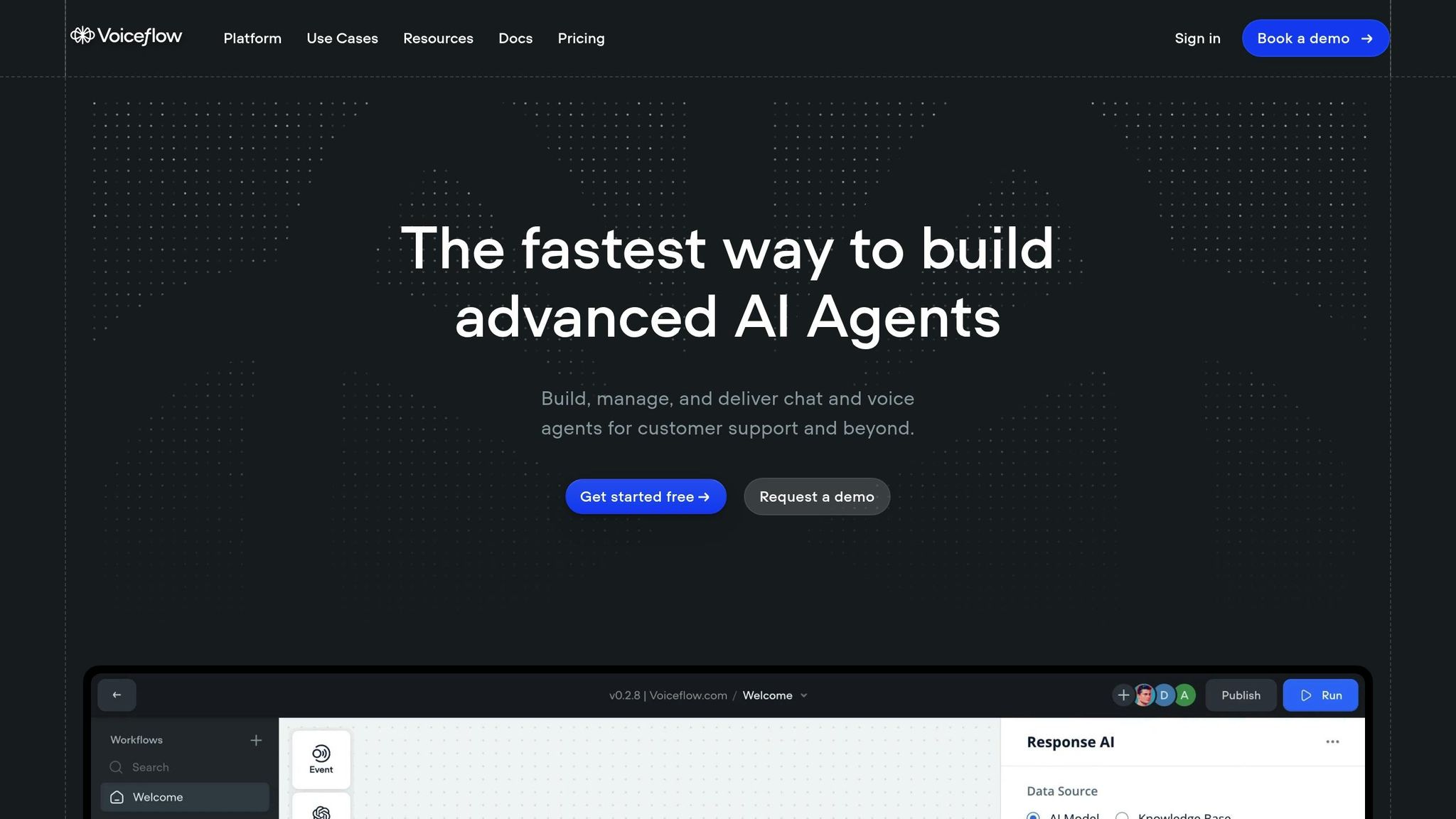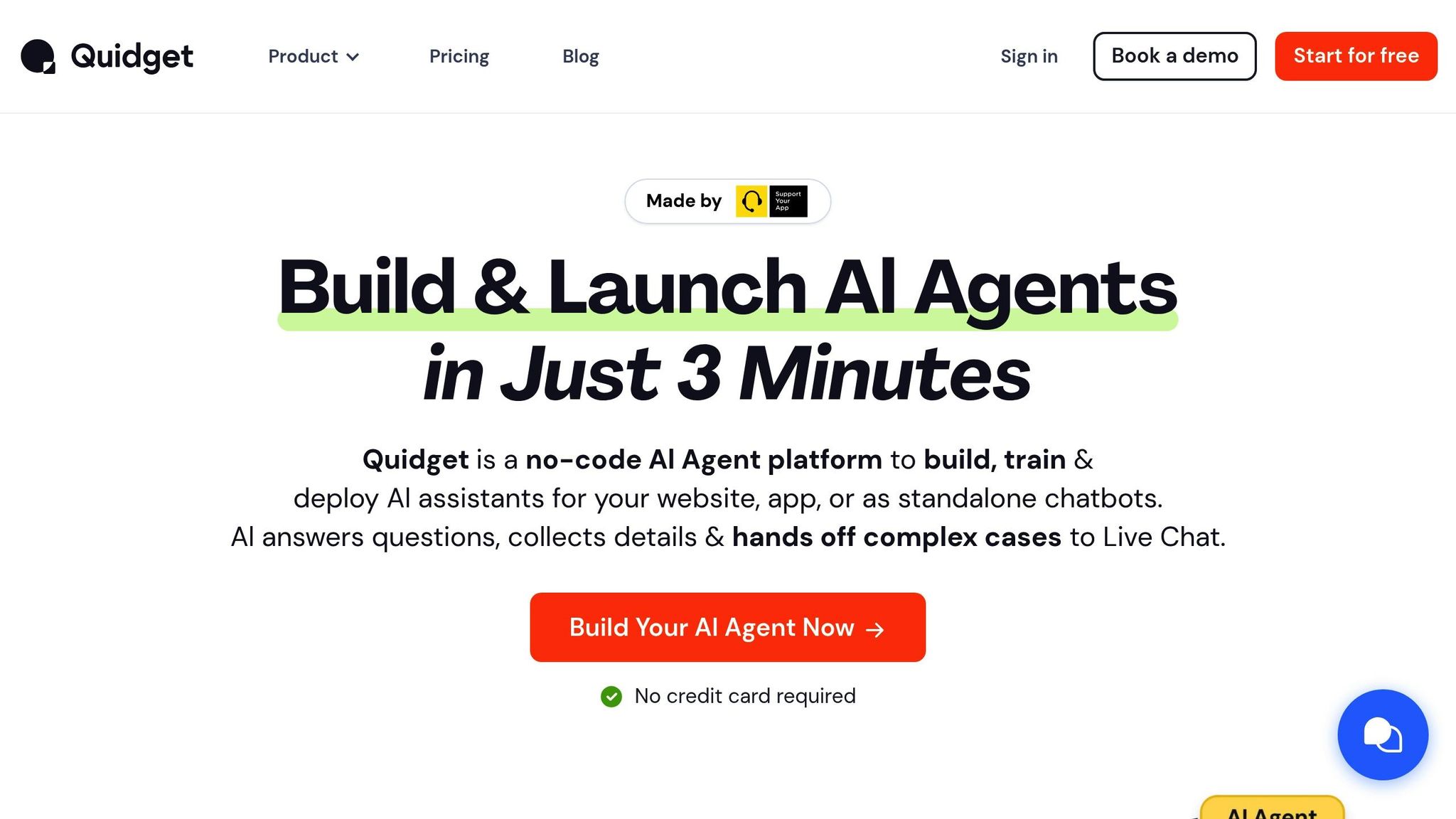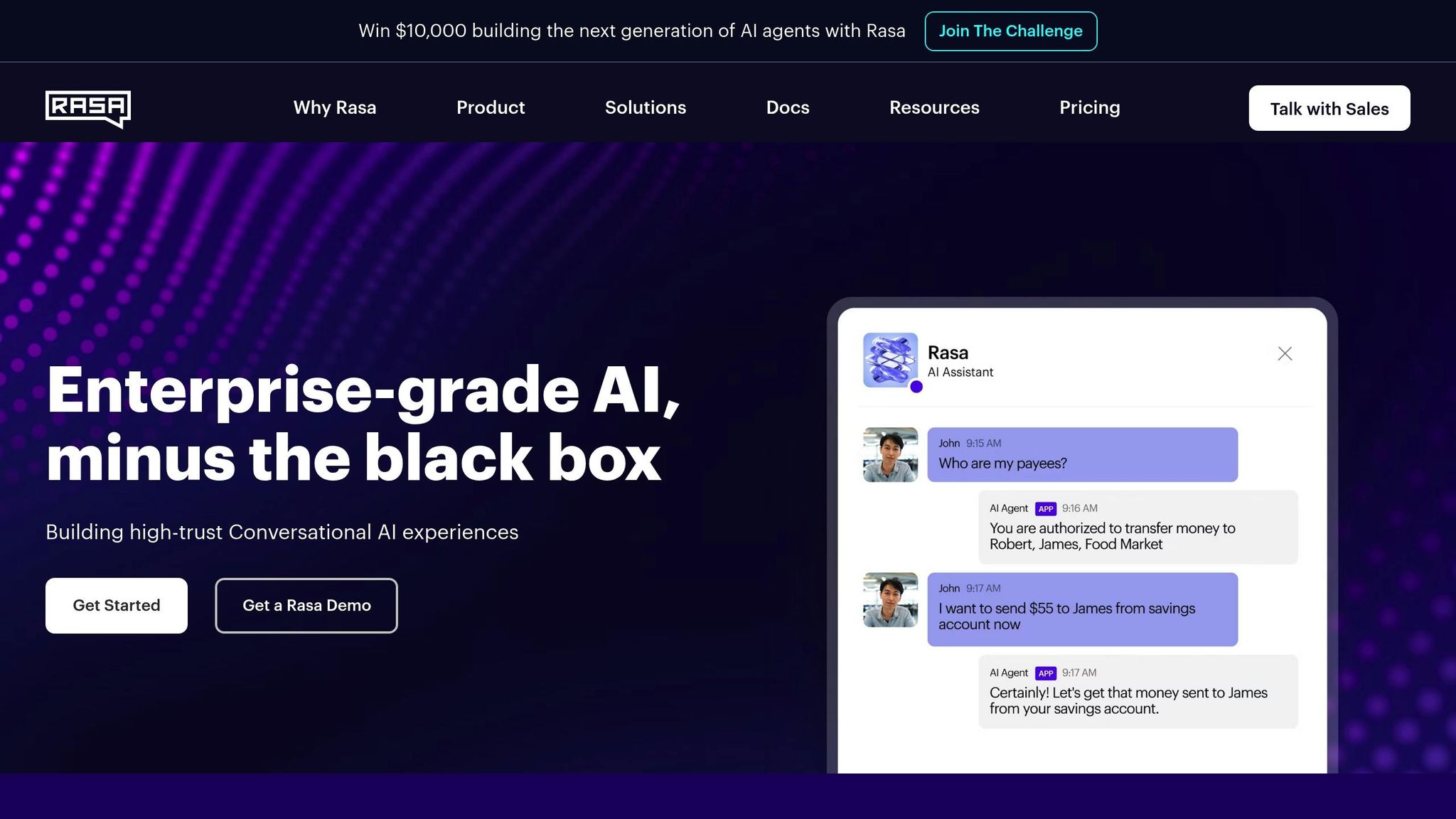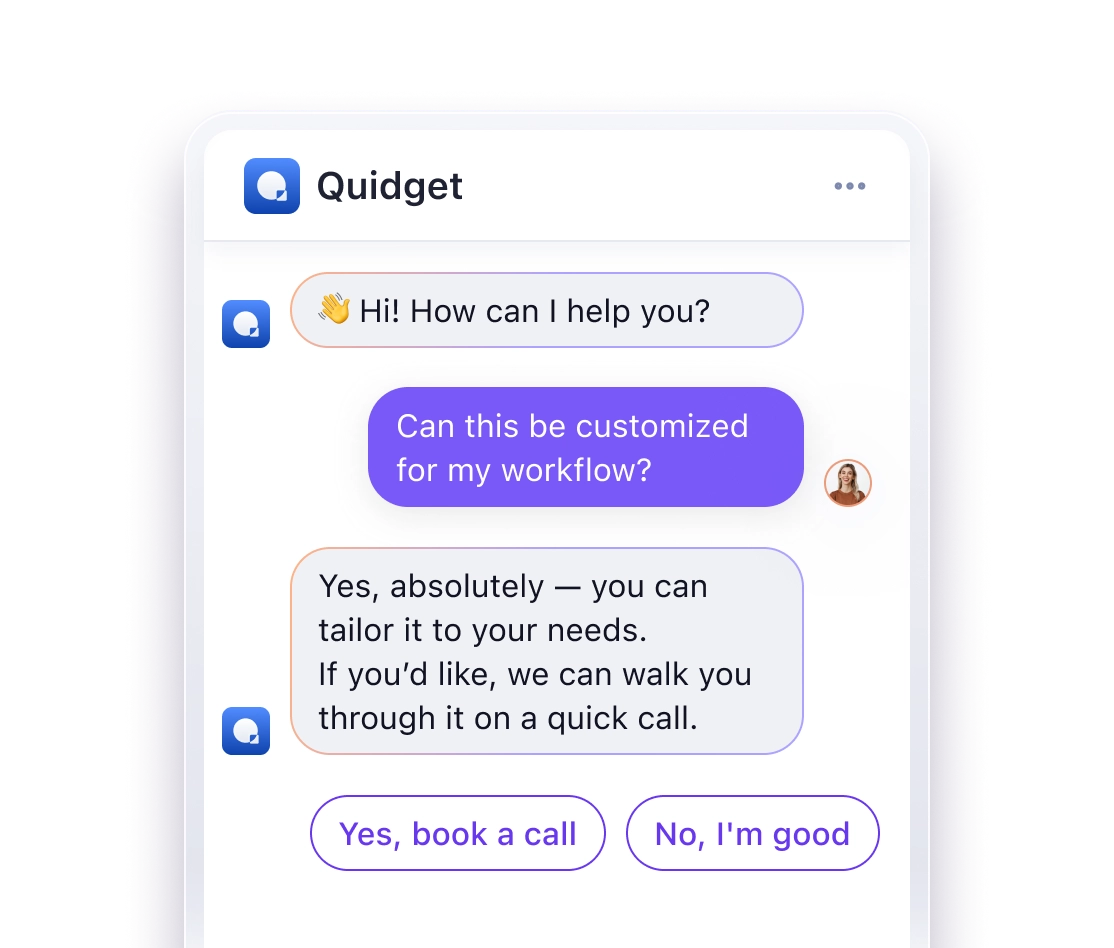How to Make a Multilingual Chatbot: Best AI Tools & Real-Time Translation
A multilingual chatbot lets you communicate with users in their preferred language, offering real-time translations and culturally appropriate responses. Here’s how you can create one:
- Choose a Platform: Options like Quidget (no-code), Rasa (developer-focused), Google AI, or Microsoft Bot Tools.
- Set Language Goals: Identify key languages and regional differences (e.g., Spanish for Spain vs. Latin America).
- Prepare Training Data: Include native phrases, regional slang, and industry-specific terms.
- Enable Translation Features: Combine AI tools like Google Translate or DeepL with human review for accuracy.
- Test and Launch: Ensure responses are accurate, culturally appropriate, and fast across all languages.
Quick Comparison of AI Tools
| Tool | Language Support | Translation API | NLP Integration | Setup Complexity |
|---|---|---|---|---|
| Quidget | 45+ languages | Built-in | Basic NLP | Easy (No-code) |
| Rasa | Customizable | External tools | Advanced NLP | High (Developer) |
| Google AI | 100+ languages | Built-in | Dialogflow | Moderate |
| Microsoft Bot Tools | 60+ languages | Azure Translator | LUIS | Moderate |
How to Create a Multilingual Chatbot in Voiceflow

Top AI Tools for Multilingual Chatbots
When building multilingual chatbots, it’s essential to use tools that handle multiple languages and facilitate natural, human-like conversations. Different tools suit different technical requirements and timelines.
Quidget – AI Agent Builder for Customer Support & Sales

Quidget supports over 45 languages, making it an excellent choice for global customer interactions.
Key Features:
- Works seamlessly with messaging platforms like WhatsApp, Slack, and Telegram.
- Handles time zone differences effectively.
Quidget’s no-code setup allows you to quickly create chatbots using your existing content, such as FAQs, knowledge bases, or website material. It can automate up to 80% of routine inquiries.
Rasa Platform

Rasa is an open-source framework designed for developers who want full control over their multilingual chatbot. It supports custom language model training, intent recognition, flexible deployment options, and advanced natural language processing (NLP).
Google AI and Microsoft Bot Tools
Both Google AI and Microsoft Bot Tools are built on robust AI infrastructures and offer comprehensive language support.
Feature Comparison:
| Feature | Google AI | Microsoft Bot Tools |
|---|---|---|
| Language Support | 100+ languages | 60+ languages |
| Translation API | Built-in | Azure Translator |
| NLP Integration | Dialogflow | LUIS |
| Deployment Options | Cloud-based | Cloud & on-premise |
These platforms are ideal for enterprise-level projects but require more technical expertise compared to no-code options.
Choosing the Right Tool
Quidget is perfect for quick implementation and broad language coverage. Rasa suits those who need a highly customizable solution. For large-scale, enterprise-grade projects, Google AI and Microsoft Bot Tools are strong choices. Success will depend on pairing the right tool with well-prepared training data and a keen understanding of regional differences.
5 Steps to Build a Multilingual Chatbot
Creating a multilingual chatbot requires a clear plan and language strategy. Here’s how to get started:
1. Set Language Goals
Begin by analyzing your target markets and identifying the languages that matter most to your business. Focus on:
- Primary markets: Where you need immediate language support.
- Secondary markets: Regions you plan to expand into later.
- Regional differences: For example, Spanish in Spain vs. Latin America.
- Time zones and support hours: Ensure coverage aligns with customer needs.
These insights will guide you in choosing an AI platform that aligns with your language strategy.
2. Pick Your AI Platform
Once your language goals are clear, select an AI platform that fits your requirements. Key factors to evaluate include:
- Supported languages.
- Translation accuracy.
- Integration options.
- Ease of setup.
- Maintenance costs.
For example, Quidget’s platform supports over 45 languages and includes built-in translation tools. This makes it a great choice for businesses aiming for a quick and efficient launch without heavy technical demands.
3. Add Language Training Data
Good training data is essential for your chatbot to understand and respond accurately in multiple languages. For each language, make sure to:
- Build conversation flows in the native language.
- Incorporate common phrases and expressions.
- Include industry-specific terms.
- Account for regional slang and variations.
This groundwork ensures your chatbot can handle real-world conversations effectively.
4. Set Up Translation Features
Accurate translation is critical for a smooth user experience. As MIT economist Daron Acemoglu points out:
"I don’t think [AI translation] is that good. I think how good AI has become is often exaggerated".
To address this, combine machine translation with human oversight. Consider these steps:
- Use machine translation but have humans review and refine it.
- Involve native speakers to check automated outputs.
- Create language-specific response templates.
- Develop fallback options for complicated queries.
- Regularly monitor and improve translation quality.
Once these systems are in place, proceed to thorough testing.
5. Test and Launch
Before launching, ensure your chatbot performs well across all languages. Here’s a breakdown of key testing phases:
| Testing Phase | Key Actions | Success Metrics |
|---|---|---|
| Initial Testing | Check basic responses in all languages | 90%+ accurate responses |
| Cultural Review | Ensure cultural appropriateness | No cultural misalignments |
| Load Testing | Test performance across time zones | Response time under 2 seconds |
| User Testing | Collect feedback from native speakers | 85%+ user satisfaction |
After launch, keep monitoring performance and gathering feedback to improve your chatbot’s accuracy and natural language capabilities over time.
sbb-itb-58cc2bf
Common Problems and Solutions
Setting up a multilingual chatbot comes with its challenges. Tackling these issues effectively is crucial for success.
Language and Culture Differences
For a chatbot to work well across languages, it must reflect cultural subtleties and regional expressions.
Regional Language Variations
Languages often differ by region. A chatbot needs to account for these differences to ensure accurate communication, especially for languages spoken in multiple countries.
Cultural Context
Research shows that over 70% of global consumers prefer interacting in their native language. To make your chatbot more effective:
- Adjust responses to reflect local language and cultural nuances.
- Develop templates tailored to specific regions.
- Customize language models and maintain cultural guidelines for each market.
Translation Quality
Accurate translations are critical to earning user trust. Here’s a structured approach to ensure quality:
| Step | Purpose | How to Implement |
|---|---|---|
| Machine Translation | Initial translations | Use tools like Google Translate or DeepL. |
| Human Review | Accuracy verification | Have native speakers review translations. |
| Context Testing | Preserve meaning | Test conversations in real-world scenarios. |
| Regular Updates | Stay relevant | Update language models and settings often. |
"When customers can chat in their own language, they feel more at ease and understood. This boosts satisfaction as they get quick answers and solutions." – SmythOS
A strong focus on translation quality ensures users enjoy a smooth and consistent experience, no matter the language.
Consistent Experience
Once translation quality is handled, maintaining a reliable and consistent experience becomes essential. Studies reveal that 60% of consumers rarely or never buy from websites offering only English.
Key steps to ensure consistency:
- Use effective language detection methods, like IP or browser settings.
- Maintain uniform response times and fallback options.
- Standardize conversation templates and flows for all languages.
- Continuously monitor performance metrics for every supported language.
Multilingual Chatbot Examples
Here are some examples of how businesses across industries are using multilingual AI chatbots to improve customer experiences and streamline operations.
Online Store Support
E-commerce companies are using multilingual chatbots to break down language barriers and provide better customer support. For example, Auralis AI has helped businesses cut their operational costs by nearly 50%, all while maintaining excellent service quality.
Key advantages for online stores include:
- Round-the-clock support in multiple languages
- Quick answers about pricing, shipping, and returns
- Automated updates on order tracking
- Real-time inventory checks
- Customer-friendly interactions in their preferred language
"Offering support in one’s preferred language ensures more engaged interactions." – Auralis.ai
The travel industry is also reaping similar rewards with multilingual chatbots.
Hotel and Travel Assistance
Hotels and travel services use these chatbots to provide seamless guest experiences.
Take The Rockley Barbados, for instance. Their multilingual chatbot has transformed customer service by:
- Answering guest inquiries 24/7
- Addressing booking concerns
- Converting website visitors into direct bookings
- Offering detailed analytics on visitor behavior
"The GuestChat chatbot has proven to be very successful, particularly in the engagement of our potential guests 24/7, answering their questions, lessening any concerns and converting online visitors into direct bookers!" – Gillian Harper, The Rockley Barbados
Similarly, Mount Cinnamon Resort & Beach Club implemented a chatbot that:
- Was easy to set up and integrate into their website
- Provided accurate information with knowledgeable support
- Increased website traffic and revealed insights into visitor interests
Language Learning Support
AI chatbots are also making waves in language learning by offering interactive and practical tools for practice. Here’s how:
| Feature | Benefit |
|---|---|
| Real-time Conversations | Practice natural, everyday dialogue |
| Cultural Context | Understand regional expressions |
| Instant Feedback | Improve grammar and pronunciation fast |
| 24/7 Availability | Learn anytime, anywhere |
Summary and Next Steps
Key Benefits
AI-driven chatbots can handle up to 80% of common customer questions in over 45 languages. Here’s how they can impact your business:
| Benefit | Impact on Business |
|---|---|
| Global Reach | Provide 24/7 support in customers’ preferred languages. |
| Cost Savings | Automate support across multiple languages, reducing expenses. |
| Scalability | Seamlessly operate on websites, apps, and messaging platforms. |
| Consistency | Deliver a consistent brand voice across all languages. |
Getting Started
Follow these steps to kick off your multilingual chatbot strategy:
- Define Your Goals
Identify the key languages your customers use and prioritize them for support. - Select a Platform
Platforms like Quidget offer no-code solutions to quickly set up your chatbot. - Launch and Refine
Once live, continuously add training data, monitor user interactions, fine-tune responses, and broaden language options.
Start your free trial today and see how AI-powered multilingual support can elevate your customer experience worldwide.



